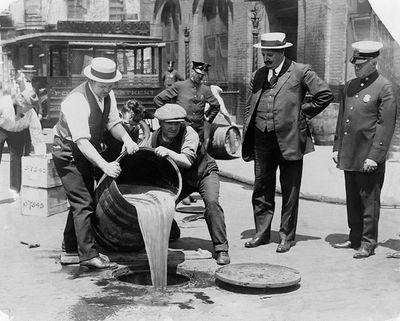Burns’ new project explores Prohibition
Encounter with historian led to three-part series

What were we thinking?
In 1918 and early 1919, with giddy thoughts of reforming society, voters in 36 states overwhelmingly approved the 18th Amendment to the Constitution, banning the sale and manufacture of intoxicating beverages.
The ban went into effect Jan. 17, 1920, but instead of going dry, America went crazy. For 13 years before repeal, the era known as Prohibition became an object lesson in unintended consequences, creating evils the Anti-Saloon League, which pushed it through, could never have imagined.
Ken Burns, whose massive documentary projects include “The Civil War,” “Jazz” and “Baseball,” was walking across the Brooklyn Bridge (another of his subjects) one day when he ran into historian Daniel Okrent.
“I know what your next project is going to be,” said Okrent, who was then working on a book about Prohibition.
Six years later, Okrent is a major presence in Burns’ “Prohibition,” which debuts Sunday on PBS.
His book, “Last Call: The Rise and Fall of Prohibition” (Scribner, 480 pages, $17 paperback), makes a wonderful companion piece to the three-part series from Burns and Lynn Novick.
“We benefited from his extraordinary research and went off on our own tangents, but most importantly, benefited from his presence in every scene of this film to make it, we think, a lot smarter,” Burns says.
Looking back on the era, we think of gangsters and flappers, bootleggers and bathtub gin. Maybe we think of “Boardwalk Empire,” the HBO series set in 1920s Atlantic City, N.J.
But “Prohibition” goes much deeper, spending its first two hours setting the scene and examining the factors (including rampant alcohol abuse) that made the ban seem like such a good idea and the motives that made so many diverse factions support it.
“The alliance that was created around the Prohibition movement was not an alliance between groups,” Okrent said. “It was a coming together because (the issue) was the one thing they shared in common.”
Women who didn’t even have the right to vote took to the streets to urge men to “vote dry.” The Ku Klux Klan and black ministers all supported it; so did the far right and the far left.
“In that regard, it’s very different from our political circumstances today,” Okrent said. The Anti-Saloon League “only cared what you thought about that one issue.”
While Okrent’s book is a weighty (but immensely readable) exploration of every aspect of Prohibition, Burns and Novick “had to pick the few stories we thought we could tell well and try to do them in enough depth that you could understand some of the themes and issues,” Novick said.
“Prohibition,” which runs just under six hours over three nights, is divided into three sections: “A Nation of Drunkards,” examining the saloon culture of the late 18th and early 19th centuries and its devastating effect on some families; “A Nation of Scofflaws,” looking at how Americans – for fun or profit – evaded the law; and “A Nation of Hypocrites,” covering the movement toward repeal.
The pace is brisk for a Burns project, although one might still wish for fewer thoughtful pauses, and the historians who are interviewed have lively things to say.
Some of the film footage is amazing, especially the home movies that researchers rounded up to show how people really lived, and partied, at the time.
In the final hours, a remarkable bit of film shot just after repeal shows an Anheuser-Busch beer wagon pulled by the brand-new Clydesdales navigating a crowded Manhattan street to deliver a case of Budweiser to Al Smith, the former New York governor and repeal supporter.
That same wagon eventually pulled up to the White House to make a delivery to President Franklin D. Roosevelt.